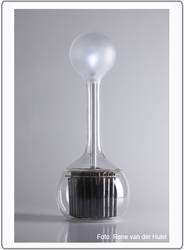
Two pots of flowers, a copper electrode in one, a zinc in the other, potting soil, a little water and here are a few milliamperes. The invention is not new but a Dutch designer has made a clock ….
Invented by the Dutch Marieke Staps, Soil Clock is a clock running thanks to the bacteria present in the soil of a flower pot to which it is attached. Copper and zinc electrodes connected to the clock are planted in the soil of two potted plants. The potting mix works as a conductor through which an electric charge can flow.
The industrial designer, who was looking for a new source of energy, came across a technique discovered in 1840, according to which the metabolic activity of the soil generates electricity. Marieke Staps applied this principle to make a standalone lamp and then tested her system with an ecological clock.

Enough to light the streets?
Unveiled at the Dutch Design Week in 2008, and exhibited at the Dwell Salon of Kitchen Ecology in Los Angeles in June, Soil Clock works well with bacteria in the soil of a bamboo pot. .
The potting soil produces enough electricity to run the clock. Marieke Staps says that his has been doing this for two years, with the only constraint of watering the plants, to feed the soil.
According to the designer, this technique could be used to recharge batteries, run computers or even light the streets.